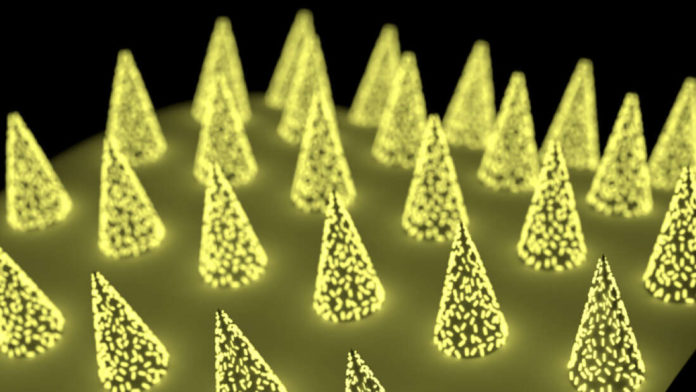
A team of engineers has devised a microneedle patch that allows ultrasensitive and timely collection of disease biomarkers.
Ever heard of trypanophobia; also, commonly known as needle phobia? Chances are you either know of someone who suffers from it or maybe have it yourself. People with trypanophobia generally avoid blood tests and even getting vaccinations. Now, engineers at McKelvey School of Engineering at Washington University in St. Louis have come up with a solution in the form of a microneedle patch. The newly developed method allows for the detection of disease biomarkers through a pain-free approach. However, instead of relying on blood, the patches utilize interstitial fluid – a liquid found between cells.
Interstitial fluid is a rich source of proteins, inflammatory markers, and nutrients. However, current extraction methods are time-consuming and only draw a small amount that is not enough for accurate analysis. Therefore, researchers developed the microneedle patch to provide an ultrasensitive and time-efficient alternative. They tested the diagnostic method on mice for various biomarkers. The research is published in the journal Nature Biomedical Engineering.
They go about 400 microns deep into the dermal tissue. They don’t even touch sensory nerves.
Professor Srikanth Singamanen
‘Plasmonic-Fluors’ – A Secret Weapon
Once a biomarker was detected, researchers used a fluorescence nanolabel called ‘plasmonic-fluors’ to indicate its quantity and presence. Compared to traditional fluorescent markers, these ultrabright nanolabel are 800 times more sensitive. Moreover, they significantly decrease sampling time.
When researchers tested the microneedle patch on mice, they found it was effective for detecting a variety of biomarkers.
Researchers believe the patch can enable at-home sampling; therefore, eliminating the need for unnecessary trips to the hospital. Moreover, allowing regular monitoring of therapy in those suffering from chronic conditions.
When someone complains of chest pain and they are being taken to the hospital in an ambulance, we’re hoping right then and there, the patch can be applied.
Jingyi Luan, lead author
In light of the pandemic, researchers hope the patches can help detect COVID-19 antibodies in response to vaccines. Thus, helping them determine how long immunity lasts with certain vaccines.
However, the diagnostic method requires extensive clinical trials before it can be approved for use. Moreover, levels of various biomarkers in the interstitial fluid are still unclear. Therefore, researchers will need to determine the normal and abnormal levels of these biomarkers before implementing them for clinical use.
Reference:
Zheyu Wang et al, Microneedle patch for the ultrasensitive quantification of protein biomarkers in interstitial fluid, Nature Biomedical Engineering (2021). DOI: 10.1038/s41551-020-00672-y



